World Cup (cricket): history
This series of articles is mainly about the World Cup insofar as it concerns South Asia. Mentions of other countries' performances are mainly limited to their performance in the finals and their performance against South Asian countries.
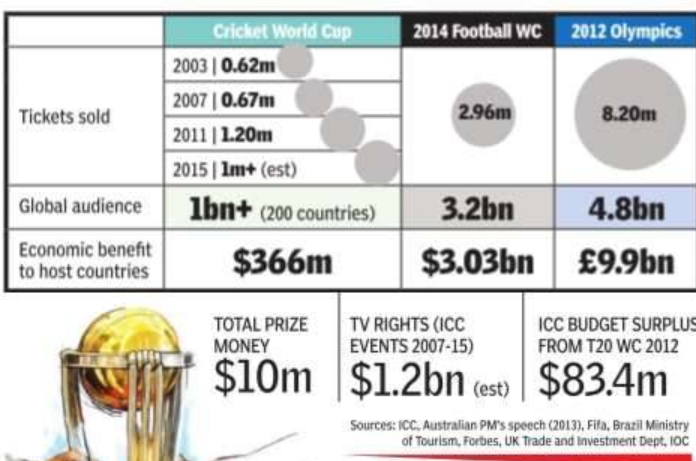
This is a collection of articles archived for the excellence of their content. |
The sources of this article include...
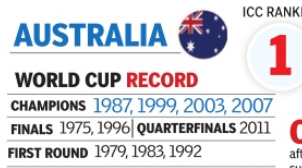
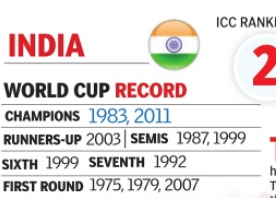
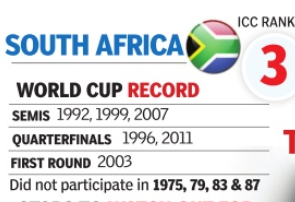
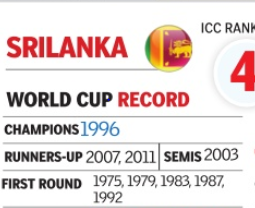
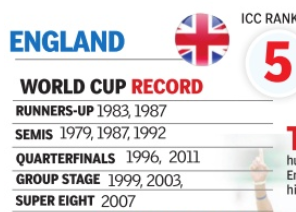
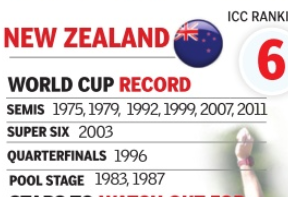
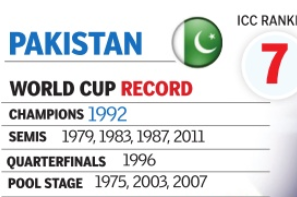
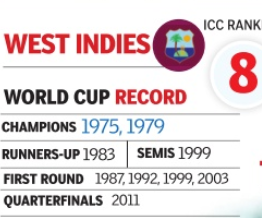
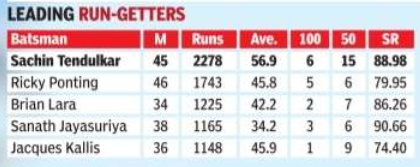
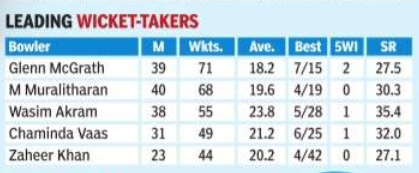
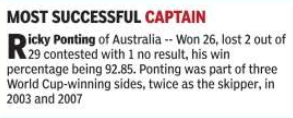
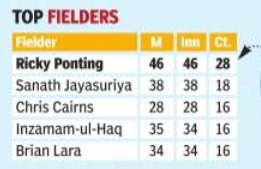
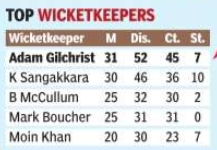

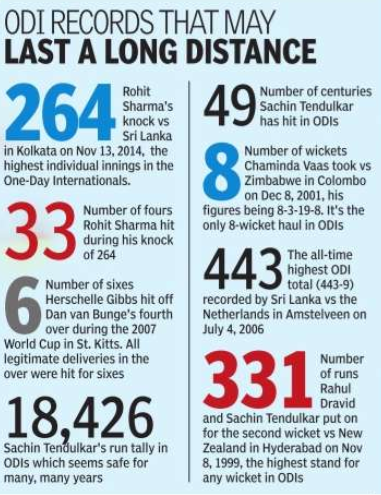
Nalin Mehta,TNN | Feb 8, 2015 The Times of India World Cup: What all has changed from 1975 to 2015 <>The Times of India Brief history of the World Cup
1975
The first Men's Cricket World Cup (Prudential Cup): venue England
Number of overs per team: 60
Uniform: white
Colour of balls: red.
Hours of play: daytime.
Participating teams: 6 test playing teams (Australia, England, India, Pakistan, New Zealand the West Indies) plus 2 (Sri Lanka, East Africa) = 8 in all
Winners: West Indies defeated Australia in the finals.
The indomitable Windies, led by Clive Lloyd, took to the format like ducks to water.The skipper himself rose to the task in the final, scoring 102 from 85 balls as the Windies scored 2918 off 60 overs. Viv Richards effected three run outs and in spite of Ian Chappell's fighting 62 the Aussies managed only 274. The dramatic finale made the One-day format hugely popular.
Nalin Mehta’s insight [1]
1975 The first cricket World Cup in 1975 was not even called the World Cup. With only 15 games and a new one-day format that everyone still saw as a "necessary evil" that followed Test matches, insurance-giant Prudential insisted as tournament sponsor that it be called the Prudential Cup.
And so it was, on the silver trophy that Clive Lloyd eventually held aloft and even in the game's bible, Wisden. Yet, charting the early history of the World Cup, cricket writer and historian Gideon Haigh argues the idea was a huge success because "like the best innovations, cricket's World Cup met a need nobody had foreseen." It fulfilled the eternal need of sports fans to dramatically square off their teams and see who was best: in a way that geeky and constantly oscillating rankings could never hope to match.
1979
Prudential Cup: venue England
All 6 test playing teams participated.
Through the ICC Trophy competition, two non-Test playing teams were selected for the World Cup: Sri Lanka and Canada.
Winners: West Indies defeated England in the finals.
Cricket was coming off the controversial Packer era split and the Windies profited by picking a fullstrength team. This time it was the authoritative Richards' turn to stroke a century (138) while Collis King came up with a breezy 86. Boycott and Brearley batted too slowly, and then Joel Garner took five wickets in 11 balls to fashion a 92-run win.
1983
Prudential Cup: venue England
Participating teams: All seven test playing teams (now including Sri Lanka), plus Zimbabwe (selected through the ICC Trophy)
Winners: India defeated West Indies in the finals.
The underdogs rose in dramatic fashion to end West Indies' Cup reign, sparking a frenzy and making the game an intrinsic part of India's cultural fabric. India scored 183, but the Windies appeared overconfident and Kapil Dev's stunning catch to dismiss Richards set up a 43-run win. From then on, ODIs became more popular than Tests.
1987
No longer called Prudential, the 1987 Cricket World Cup was co-hosted by India and Pakistan.
It was now the Reliance World Cup
Number of overs: 50
Participating teams: 8 (Australia, England, India, New Zealand, Pakistan , Sri Lanka, West Indies, Zimbabwe)
Winners: Australia defeated England.
The first-ever World Cup in the subcontinent didn't see any home teams in the final at the Eden.Mike Gatting's reverse sweep off Australian captain Allan Border ended in fatal consequences for England as they lost by 7 runs. The first-ever 50-over Cup saw the Aussies emerge as a major force in the tournament.
1992
Venue: Australia and New Zealand
Uniform of players: A different coloured uniform for each eam
Colour of balls: white
Hours of play: day/night
Participating teams: Participating teams: Australia, England, India, New Zealand, Pakistan, South Africa, Sri Lanka, West Indies, Zimbabwe
South African participated for the first time.
Winners: Pakistan defeated England in the finals.
Imran Khan's glory boys emerged from near elimination in the early rounds to reign supreme at the MCG, with the captain scoring 72 at No. 3 in his final match. Wasim Akram then blew away Botham, Lamb and Co. Coloured clothing, white balls and floodlights all made their debut.
1996
The Wills World Cup
Venue: The Indian subcontinent (India, Pakistan and Sri Lanka)
Participating teams: Australia, England, India, Kenya, the Netherlands, New Zealand, Pakistan, South Africa, Sri Lanka, United Arab Emirates, the West Indies, Zimbabwe
Kenya and Zimbabwe were included.
Winners: Sri Lanka defeated Australia in the final.
Sri Lanka made a strong statement for the minnows worldwide by pulling off a landmark heist, riding on the genius of `Mad Max' Aravinda de Silva, Arjuna Ranatunga's bold leadership and his canny use of strategy to exploit early field restrictions and attack from the first ball of the match.
1999
Venue: The United Kingdom (mainly England but also Wales/ Ireland and Scotland) and the Netherlands.
Participating teams: twelve (as below).
Full Members: Australia, England, India, New Zealand, Pakistan, South Africa, Sri Lanka, the West Indies, Zimbabwe
Associate Members: Bangladesh, Kenya, Scotland
Winners: Australia defeated Pakistan in the final.
Australia began an era of domination, winning the first of three successive Cups. The final was a nocontest as Pakistan capitulated but the best moments came in Australia's semifinal, when a panicky run-out ensured a loss for SA when they needed only one from four balls.
2003
Venue: South Africa, Zimbabwe and Kenya.
Participating teams: fourteen (as below):
Full Members: Australia, Bangladesh, England, India, New Zealand, Pakistan, South Africa, Sri Lanka, the West Indies, Zimbabwe.
Associate Members: Canada, Kenya, Namibia, the Netherlands.
Winners: Australia defeated India in the finals.
Sourav Ganguly's India rode on brilliant performances from `Master Blaster' Sachin Tendulkar to enter the final on a hot run, but were deflated by an imperious Ricky Ponting, who struck 8 sixes in a match-winning 140 not out.In India, however, cricket had made the transition to a hugely marketable brand.
2007
Venue: the West Indies.
Participating teams: sixteen (as below):
Full Members: Australia, Bangladesh, England, India, New Zealand, Pakistan, South Africa, Sri Lanka, the West Indies, Zimbabwe
Associate Members: Bermuda, Canada, Kenya, Ireland, the Netherlands, Scotland
Winners: Australia defeated Sri Lanka in the final.
The lengthy format, thinning crowds, India's early exit and the death of Bob Woolmer all threatened to overshadow the cricket, but eventually the strongest team, Australia, had its say, winning controversially in the twilight against Lanka.Adam Gilchrist was the hero this time.
2011
Venue: The Indian sub-continent (India; Sri Lanka; Bangladesh). The International Cricket Council (ICC) removed Pakistan from the list of co-hosts after the 2009 attack on the Sri Lankan national cricket team in Lahore.
Participating teams: fourteen (as below):
Full Members: Australia, Bangladesh, England, India, New Zealand, Pakistan, South Africa, Sri Lanka, the West Indies, Zimbabwe
Associate Members: Canada, Ireland, Kenya, Netherlands
Winners: India defeated Sri Lanka in the final.
MS Dhoni's unit lived up to its formidable reputation by pulverizing all in their path, the skipper himself dramatically seizing the reins with the bat in the final to enable his team to become the first to win the Cup on home soil.
2015
Venue: Australia and New Zealand.
Participating teams: 14 (Afghanistan, Australia, Bangladesh, England, India, Ireland, New Zealand, Pakistan, Scotland, South Africa, Sri Lanka, United Arab Emirates, West Indies, Zimbabwe)
Winners: Australia beat New Zealand in the final to win its fifth World Cup
How the 2015 WC is different: Nalin Mehta [2]
2015 Cricket's World Cup 2015 is very different from its first edition. Starting on Valentine's Day with 42 matches over 43 days, 14 teams and an estimated global TV audience of over 1 billion, it may be dwarfed in size by the Olympics or the soccer World Cup but remains the holy grail of the cricketing world and generates significant business, much of it in India.
With Amitabh Bachchan sitting in the commentary box for the India-Pakistan game and commentary also in regional languages, it also promises to be a different viewing experience, reflective as much of India's madness for the game as that madness shaping it.
There is a reason why the tournament's first half in the group stages is essentially predictable: to ensure against an early exit by India or any of the big teams. Organizers and sponsors know what happened in 2007 when India and Pakistan crashed out of the Caribbean World Cup early. It killed TV interest in India and ruined the business that sustains such events. In 2015 everyone waited for the quarterfinals when the big games really began.
Australia has always been seen as the land of pace and bounce, and New Zealand of seam and swing. Five of seven knockout games in this World Cup, therefore, were played on drop-in pitches, curated away from the venue and dropped in before the games, which significantly reduced the special peculiarity of local playing-conditions. The advent of pre-fabricated surfaces even prompted one Australian writer to call the tournament a "rental World Cup".
The other big change from the 2011 World Cup is the introduction of two new balls: one from each end. This is a good move aimed at checking the batting bias in one-day internationals (ODIs), with batsmen scoring more and more runs in each edition of the World Cup. The 1996 and 1999 editions produced over 14,000 runs each, but from 2003 onwards, each World Cup had produced over 18,000 runs. The two new balls rule was expectedto aid fast bowlers but may also diminish the role of spinners. India, with its mediocre bowling attack, for example, faced an uphill task.
A 2007 [Indian] legislation mandated compulsory telecasts of Indian cricket matches on public broadcaster Doordarshan (DD), irrespective of whether it had bought rights or not, the tortuous travails of legal cricketing battles around TV have been almost riveting as those on it. In 2015, Delhi High Court weighed in, ruling that DD can only show the matches on its terrestrial network, not on its channels compulsorily carried on cable and satellite.
Taking into account the huge money paid by broadcaster Star India for these matches, a bench of Justices B D Ahmed and Vibhu Parekh ruled that the law meant to provide "access to the largest number of viewers, on a free-to-air basis" and its ruling seeks to balance these two factors. "There is no change in law as a result of this," says a Star India spokesperson. "However, the implementation of this Act till now was flawed as these events of national importance were available to private cable and DTH operators as well. The High Court has only held that this is incorrect per the Act."
After a year in which the ODI ratings consistently lagged behind those for T20 ratings and the ODI-format itself faced questions, the World Cup 2015 was expected to give it a fillip. In 2014, peak ratings for ODI series dipped to 2.0 TVR (compared to 3.9-4.1 in 2011-13).
Whether it was Kapil running backwards for an eternity from mid-on to send Viv Richards back in the 1983 finals or Imran's famous pep-talk in his "ready-to-pounce" T-shirt in 1992, every World Cup brings with it its own legend. In 2011, it was about Sachin and the palpable desperation of one man for the Cup that animated India.
India’s best performers
1975-2015
Text: Prasad Ramasubramanian, May 19, 2019: The Times of India
STAR TURN
INDIA’S BIGGEST CUP PERFORMERS
ABID ALI (1975)
The Hyderabadi allrounder was one of the shining lights in an otherwise forgettable campaign. Abid Ali scored a scintillating 98-ball 70 in a knock containing five fours and a six in a mustwin game against New Zealand but was overshadowed by Glenn Turner’s unbeaten 114.
MOHINDER AMARNATH (1983)
The allrounder made handy contributions right through India’s triumphant WC campaign in 1983. In the last-four clash against England, Amarnath’s man-of-the-match performance (2/27 followed by 46) was instrumental in India making the final. In the summit clash against West Indies, Amarnath negotiated the quicks with a handy knock of 26 and then shone with the ball, bagging 3/12 to help Kapil Dev’s boys reign supreme. Michael Holding was the last Windies player to get out off Amarnath’s bowling and the allrounder’s run to collect a stump made for an iconic photo.
SUNIL GAVASKAR (1987)
The Little Master was in prime form in the 1987 edition, leading the team’s batting charts with 300 runs from 7 outings. The tournament also saw Gavaskar register his first and only ODI ton in a matchwinning effort against New Zealand in Nagpur. The tournament saw Gavaskar and Kris Srikkanth provide solid starts on more occasions than one. However, the batting legend’s tournament (and international career) ended on a sorry note as he was dismissed for 4 in India’s 35-run loss in the semis.
SACHIN TENDULKAR (1996)
The 1996 edition of the World Cup saw Sachin Tendulkar consolidate his position as one of the leading players in ODIs. His water-tight technique and ability to manufacture strokes was a big factor in India making the semifinals.
Tendulkar etched his name in the record books by becoming the first batsman in WC history to score over 500 runs in a single edition. His unlucky dismissal at Eden Gardens against Sri Lanka shattered India’s dream of making the final.
RAHUL DRAVID (1999)
Rahul Dravid may have taken time to find his footing in the 50-over format, but once he did, he became a crucial cog in the wheel. The 1999 WC saw him at the peak of his powers. Dravid was the tournament’s leading rungetter with 461 runs, with two hundreds and three halfcenturies to his name. What was most impressive about Dravid was the ability to pace his innings to perfection and bring solidity to the middleorder. His 318-run second wicket partnership with Sourav Ganguly against Sri Lanka in a must-win game was a bright spot for India in an otherwise unhappy campaign.
SACHIN TENDULKAR (2003)
Tendulkar was in imperious touch during this edition of the World Cup. The highlight of Tendulkar’s golden run in the competition — where he scored 673 runs — was the Centurion game against Pakistan. Against a top-quality attack comprising Wasim Akram, Waqar Younis and Shoaib Akhtar, Tendulkar dominated from the word go and set the platform for India’s win. The tournament didn’t end on a great note for the legend, though, as he failed to fire in the crucial final game.
YUVRAJ SINGH (2011)
Consistent shows with the bat and ball marked Yuvraj’s run in the 2011 WC. The player of the tournament scored 362 runs and also bagged 15 wickets with his left-arm spin. A 50-ball 58 against England followed by handy contributions against Ireland and Netherlands saw him get into the groove. He followed that with a well-compiled hundred and a two-wicket haul against West Indies. Yuvi’s crucial 57 in the quarterfinals ended Australia’s 12-year dominance in ODI World Cup contests. He made it count with the ball vs Pakistan in the semis.
SHIKHAR DHAWAN (2015)
The southpaw ended up with 412 runs to his name from 8 outings. Dhawan started off with a fluent 73 in India’s tournament opener against Pakistan. He followed that up with a brilliant 137 against the Proteas which set up India’s 130-run win. Dhawan was in full flow against Ireland as well, scoring an 85-ball 100 as India cruised to an easy win. His innings of 45 in the semifinals against Australia set things up for India but the team failed to capitalize on it and lost the clash by 95 runs.
India’s captains
1975-2015
May 15, 2019: The Times of India
LEADING THE BRIGADE
Profiles of India’s World Cup captains
S VENKATARAGHAVAN (1975 & 1979)
Known to be a shrewd thinker, offie S Venkataraghavan was given the mantle of leading India in the 1975 and 1979 World Cups. India were no more than ODI minnows and won just one game out of six. Venkataraghavan, too, couldn’t make much of an impact, failing to take a single wicket from six matches. Apart from the two World Cups, Venkataraghavan also led India during their tour of England in 1979.
KAPIL DEV (1983 & 1987)
Kapil Dev will always enjoy an exalted place in India’s cricketing history. While he is still considered India’s greatest allrounder, Kapil’s most defining contribution came as leader of the Indian team during the 1983 World Cup. Expected to just make up the numbers when the tournament started, Kapil’s Devils went all the way and transformed the cricketing world forever. Kapil, of course, was the chief architect, scoring a majestic 175 not out against Zimbabwe to pull India out of trouble, not to forget his brilliant catch to get rid of Viv Richards in the final.
MOHAMMAD AZHARUDDIN (1992, 1996 and 1999)
Azharuddin has the distinction of being the only Indian skipper to lead in three successive World Cups. In 1992, Azhar couldn’t motivate the side as they won just 2 of 8 matches. Four years later, it was a different story as Sachin Tendulkar singlehandedly carried India’ into the semifinals and made Azhar’s task of leading the team a lot easier. The 1999 World Cup wasn’t a happy outing for Azhar as his team remained inconsistent and failed to cross the Super Six stage. Azhar was subsequently sacked as skipper.
SOURAV GANGULY (2003)
Sourav Ganguly and his Indian team fell just one step short of emulating Kapil Dev’s boys when they lost in the final to Australia in Johannesburg.
India had started the tournament patchily but their fortunes quickly turned around, thanks to a combination of excellent individual performances and Ganguly’s leadership capabilities. The left-hander was equally impressive with the bat in hand, finishing as the second highest run-getter in the World Cup with three centuries, just behind Sachin Tendulkar.
RAHUL DRAVID (2007)
Four years after making the final in South Africa, India’s campaign in the Caribbean ended in humiliation as Dravid’s boys bowed out in the group stage. Dravid had the likes of Tendulkar, Yuvraj Singh, Sourav Ganguly, Virender Sehwag by his side but they couldn’t click as a unit. Coach Greg Chappell seemed to be calling the shots and Dravid struggled to keep everyone on the same page at that time.
MS DHONI (2011 & 2015)
MS Dhoni had a quiet tournament in 2011 before he came to the party in the all-important final against Sri Lanka. His unbeaten 91 not only won India their second ODI World Cup crown but also placed Dhoni among the pantheon of all-time limited-overs greats. Right through the tournament, Dhoni’s game-awareness and calmness under pressure stood out. In the subsequent edition Down Under, Dhoni once again marshalled his resources well but their run concluded with the loss to Australia in the semifinal.
—Compiled by Vivek Krishnan and Prasad Ramasubramanian
ODI cricket/ World Cup: changes
1992-2015
Nitin Naik, May 28, 2019: The Times of India
CHANGE, THE ONLY CONSTANT
Since the 1992 World Cup, ODI cricket has been in a state of constant flux. New rules have been added and some scrapped to try and make the game more dynamic. Here are some of the major ones that proved to be game-changers over the years
To make itself global and compete with more lucrative, shorter and TV friendly sports, cricket, especially, ODI cricket has changed its rules frequently. The biggest of course, came in the 1992 World Cup in Australia and New Zealand, when for the first time, the mega event staged day night matches and players wore coloured clothing.
When the much watched and followed Tri-series in the mid-80s, was beamed to Indian TV screens, one had already got familiar with the 30-yards circle and only two fielders allowed outside. Those rules though were not followed when matches were staged outside. The 1992 World Cup though saw these rules crystallised. The impact: Mark Greatbatch, the Kiwi opener who was known as a strokeless wonder for his defensive game, was unchained by skipper Martin Crowe and given the license to go after the bowling in the first 15 overs. It proved a resounding success. The idea was then carried forward by Sri Lanka’s dashing openers, Sanath Jayasuriya and Romesh Kaluwitharana, who were told by captain Arjuna Ranatunga to attack the new ball. The formula not only won Sri Lanka the1996 World Cup, it also was copied by other teams and made pinchhitting a phenomenon in the late 90s and Jayasuriya became a cult figure.
After the Asia Cup final in 1997, where Sri Lanka chased down 240 in less than 37 overs, Indian skipper Sachin Tendulkar was asked what would be a safe total against Jayasuriya, “May be 1000,” an exasperated Sachin said, before going on to give Jayasuriya the ultimate compliment. “I haven’t seen Don Bradman bat. But I have seen Sanath Jayasuriya. I haven’t seen a better batsman in m y cricketing career.”
A STAGNANT PERIOD TILL 2005
After the initial excitement of seeing cowboyish batting in the first 15 overs wore off, ODI cricket suffered from stagnation. The middle overs (overs number 16 to 40), became a bit boring. With the field spread out, batsmen and teams were content to just consolidate and milk the bowlers for ones and twos and chose to keep wickets in hand for the last 10 overs. With the advent of Twenty20 in 2003 and the ICC planning to stage a world event once every two years, ODIs started crying for innovation.
IMPACT: BIRTH OF THE POWERPLAY IN 2005
The term was coined by the ICC in 2005 to break up the existing pattern and introduce three sets or passages of field restrictions. Instead of two fielders being allowed outside the 30-yard circle till the 15th over, the rules stated that two fielders outside the 30-yard circle rule is mandatory only till the 10th over. The fielding team was given the choice to then choose two sets of five overs each when an extra fielder was permitted outside the 30-yard circle.
2008: Birth of the batting powerplay: In 2008, the ICC stepped in again to make the powerplays more interesting and putting the onus on captains to think dynamically. They introduced the batting powerplay where in the batting team could decide when to use the five overs where only three fielders were permitted outside the 30-yard circle.
Impact: A lot of teams started holding on to the powerplays till the 46th over thereby giving the batsmen a free swing in the slog overs and making bowlers cannon-fodder.
2011: More changes: Sensing that bowlers were getting short-changed, the ICC tweaked the rule further and made it mandatory for all the powerplays to be used between the 16th and 40th over. In non powerplay overs, teams were allowed five fielders outside the circle.
The Decision Review System, too, was first used in the 2011 World Cup and India were one of the top beneficiaries when Sachin Tendulkar was adjudged not out by the third umpire in the semifinals against Pakistan after he was given out. Tendulkar’s 85 went a long way in winning that game for India.
2012: HELLO BATSMEN, GOODBYE BOWLERS
The ICC made the ODIs more favourable to the batsmen in 2012 when they reduced the number of fielders outside the 30-yard circle in non powerplay overs to just four. Three powerplays were reduced to two with the bowling powerplay being discarded. Impact: Lot of 300-plus scores achieved and chased down.
HELLO AGAIN, BOWLERS.
SORRY ABOUT 2012
Sensing that the bowlers were getting a hiding, the ICC got together again and discarded the batting powerplay. The bowlers got more protection in the last ten overs with an extra fielder outside the circle. Current rules about field restrictions are these: P1: 1 to 10 overs with two fielders permitted outside the 30-yard circle. P2: 11 to 40: Four fielders outside the 30-yard circle. P3: 40 to 50: Five fielders allowed.
SHUT UP AND BOUNCE BABY
The one thing that excites fans on TV and those in the stadiums is a fast bowler running in, banging the ball short and bouncing the batsmen out or causing them discomfort by making them hop around. In the 1992 World Cup, the ICC had allowed one bouncer an over. Not only is it an effective dot ball, it can also be used as an attacking option, if bowled well.
In 1994, the ICC increased it to two bouncers an over. If the bowler bowled a third one over the shoulder, two penalty runs were given. In 2001, the ICC again went back to one bouncer an over. In 2012 though, the second bouncer was allowed and penalty removed. A third bouncer is declared a no ball with a free hit.
2011, NEW BALLS PLEASE
To help the bowlers in an increasingly batsman-dominated game, the ICC thought of introducing two new balls from each end. Instead, the move spectacularly backfired. Prior to October2011, the umpires had the option of replacing the ball at the end of the 34th over if they found it to be discoloured. It hurt the bowlers who had worked hard to keep it rough on one side to help them get reverse swing. But with two new balls at each end, reverse swing and spin was almost non-existent and it ended up in batsmen getting huge scores and hitting the ball harder and farther. Since 2011, 300 scores of 300-plus have been registered in ODIs. Seven out of eight double centuries have been scored after the two new balls rule. 11 times 400-plus has been scored. South Africa need 22 runs from 1 ball? How many of you remember this visual on the giant scorecard of the SCG in the semifinal of the 1992 World Cup between South Africa and England. A shower that lasted 10 minutes made the target of 22 from 13 balls into 22 off 1 and knocked South Africa out. The ridiculous rain rule in the tournament meant that if rain interrupted play, the target that would be reduced would be proportional to the least profitable overs of the team that took first strike.
In 1999, the Duckworth Lewis method was introduced. According to the method, a rain interruption took into account several factors like run-rate, wickets lost and wickets in hand. Despite the occasional heartburn, it still is considered reasonably fair although experts do feel that in case of a t20 game which is reduced to six overs, the team batting second having all 10 wickets in hand does give it an unfair advantage.
2005: SUPERSUB OR SUPERDUD
Inspired by rolling substitutions in football and hockey, the ICC, in 2005, introduced the supersub rule on an experimental basis. The competing teams were allowed to name a 12th player during the toss who could substitute one of the players at any time in the game.
It produced excitement and fanfare initially and even curiosity. But it was thought to be unfair on the team losing the toss and calls were made for the team losing the toss to name the supersub after the toss.
The most famous instance of the rule being disadvantageous to the team losing the toss was noticed in the 2005 Tri-series in Zimbabwe in a match involving India and New Zealand. The Kiwis were bowled out for 215 and they had named pacer Shane Bond as their supersub. In the second innings, they replaced Nathan Astle with Bond and the fiery pacer blew India away with 6-19. Former India pacer Agarkar, who played quite a few games during the period when the supersub rule was in effect, says: “The rule did not last long, but barring the odd occasion, we generally benefited from the rule as we did not have an all-rounder those days and we could substitute a bowler with an out and out batsman or vice-versa.”
Stats indicated that 60% of the team winning the toss ended up winning the game during the supersub era. The ICC scrapped the rule in March 2006 with Australia captain Ricky Ponting’s views against it being the proverbial last straw that broke the camel’s back.
“I don’t think there’s anything lost by going back. We’ll keep trying and making the best of it, but I’d like to see us going back to 11 against 11 for the World Cup.”
Some defining moments
Nitin Naik, May 28, 2019: The Times of India
RUN FEST: Martin Guptill (237*) hammered the highest individual score in World Cup history, making the most of revised field restrictions that severely handicapped bowlers in the 2015 World Cup
OPENING BURST: Kiwi opener Mark Greatbatch changed the way the game would be played when he launched into rival attacks when field restrictions were in place in the first 15 overs during the 1992 WC
OUT OF THE BLUE: Sanath Jayasuriya and Romesh Kaluwitharana were unstoppable in the 1996 World Cup and it led to Arjuna Ranatunga (l) lifting the World Cup as the Lankan captain
SYSTEM ISSUES: DRS created a storm in the 2011 WC when an lbw appeal by India against Ian Bell was negated even though the ball was hitting the stumps. Bell survived as he was more than the stipulated 2.5m away from the stumps
RUN FEST: Martin Guptill (237*) hammered the highest individual score in World Cup history, making the most of revised field restrictions that severely handicapped bowlers in the 2015 World Cup
India’s best and worst
1975-2015

From: May 29, 2019: The Times of India
See graphic:
India’s best and worst performances at the World_Cup, 1975-2015.
Fascinating facts about World Cups
Author: MS Ramakrishnan, Bangalore, Thu, Jan 22 2015 CricBuzz 1 <>CricBuzz 2 <>CricBuzz 3 <>CricBuzz 4 <>CricBuzz 5
1977: The revolution of ODI cricket Many top cricketers turned pirate with the inception of the Kerry Packer series in 1977. It was this series which paved way for the modernization of ODI cricket with coloured clothing and floodlit fixtures coming on later. Eventually, since 1992, teams began to the play the World Cup with coloured clothing and white cricket balls.
Man of the Match awards: Men for the big occasion Mohinder Amarnath (1983), Aravinda De Silva (1996) and Shane Warne (1999) hold the unique record of winning Man of the Match awards in both semifinal and final of the World Cup games.
Bowling averages: The best and worst bowling average Pakistani batsman Mohammad Yousuf has the best bowling average (0.00) in World Cup history. Yousuf took the wicket of Zimbabwe's Christopher Mpofu with the very first ball he bowled in the 2007 World Cup. Contrastingly, New Zealand off-spinner John Bracewell has the worst average. Featuring in two World Cups (1983, 1987), Bracewell played seven matches, conceded 310 runs and picked up just 1 wicket, meaning he had an average of 310.
Highest run-getter in World Cups During his knock of 52 against the Netherlands in the 2003 World Cup, Sachin Tendulkar surpassed Javed Miandad (1083) to become the highest run-getter in World Cup history. Eventually, Tendulkar finished with 2278 runs in World Cups.
Youngest World Cup winner Aged 22 years and 3 months, Piyush Chawla was the youngest to taste World Cup success when MS Dhoni's devils defeated Sri Lanka in Mumbai in 2011.
Highest (cumulative) number of runs scored in all World Cup matches put together 2278 Runs scored by Sachin Tendulkar in 45 matches, the most in Cup history. The Times of India
Highest individual score 188: by South Africa's Gary Kirsten against UAE in '96 The Times of India
Highest (cumulative) number of wickets taken in all World Cup matches put together 71 Wickets by Australia's Glenn McGrath in 39 games, the most in WCs The Times of India
PART B: STATISTICS
Batting
Some great innings: 1975-2015
Compiled by Prasad RS, May 28, 2019: The Times of India
KNOCK-OUT PUNCH
There have been many great knocks played in the World Cup. TOI takes a look at the top-8 which were played under tremendous pressure and helped their teams march towards victory
CLIVE LLOYD (102 Vs AUSTRALIA IN 1975 FINAL)
The West Indies skipper’s 85-ball 102 was the highlight of the 1975 World Cup final against Australia.
The southpaw’s innings — a mixture of power and panache — lit up the Lord’s. His knock — against an attack comprising the formidable duo of Dennis Lillee and Jeff Thomson — eventually helped West Indies win the first World Cup final by 17 runs.
KAPIL DEV (175* Vs ZIMBABWE IN 1983 GROUP STAGE)
Kapil Dev produced one of the greatest-ever ODI innings as his unbeaten 175 helped India beat Zimbabwe in a must-win game at Tunbridge Wells in the 1983 World Cup. Walking in with India tottering at 17 for 5, Kapil turned things around with his genius. Kapil’s single-handed effort ensured India won the contest by 31 runs.
INZAMAM UL HAQ (60 Vs NEW ZEALAND IN 1992 SEMIS)
Chasing 263 for victory, Pakistan were down in the dumps when the little-known Multan boy walked in. During the course of his 37-ball 60 on a slow pitch at Auckland, Inzy tore into the Kiwi attack and announced himself to the world, setting up the Pakistan win en route to their World Cup triumph. True to Inzy style, he got run out with the team still needing 36, but the experienced Javed Miandad and Moin Khan finished it off.
ARAVINDA DE SILVA (107* Vs AUSTRALIA IN 1996 FINAL)
Aravinda de Silva’s 124-ball 107 in the 1996 World Cup final against Australia was an innings of the highest quality. Chasing 242, Sri Lanka lost their in-form openers — Sanath Jayasuriya and Romesh Kaluwitharana — with just 23 on the board. De Silva rebuilt the Lankan innings first with a 125-run third-wicket stand alongside Asanka Gurusinha before partnering skipper Arjuna Ranatunga to take the island nation past the finishing line.
SACHIN TENDULKAR (98 Vs PAKISTAN IN 2003 GROUP STAGE)
Chasing a daunting 274 against a topclass Pakistan attack, Tendulkar’s vicious assault on Wasim Akram, Waqar Younis, Shoaib Akhtar and Abdul Razzaq set up a memorable win for India. The Little Master, unlike other matches, decided to face the first ball and his six over point off Akhtar in the second over set the tone for a brilliant day for the Indian cricket fans.
STEVE WAUGH (120* Vs SOUTH AFRICA IN 1999 SUPER SIX)
The Australia-South Africa Super Sixes contest in the 1999 World Cup at Leeds will be remembered for Steve Waugh’s fighting hundred.
Chasing 272 set by South Africa, Australia, in a must-win situation to qualify for semis, needed Steve Waugh’s calm head to stay in the hunt. The skipper arrived at the crease with his side placed at 48 for 3 and began the rescue act. While Waugh’s unbeaten 120 helped Australia win by 5 wickets, he enjoyed a slice of luck when Herschelle Gibbs dropped him on 56. The Australian skipper is reported to have told Gibbs that he had just dropped the World Cup.
RICKY PONTING (140* Vs IND IN 2003 FINAL) The 2003 World Cup final between India and Australia will be remembered for Ricky Ponting’s belligerent 140. With shots all around the Wanderers Stadium in Johannesburg, Ponting tore into the Indian attack. Despite Sourav Ganguly employing as many as 8 bowlers in the innings, none could stop Ponting’s onslaught as Australia notched up 359-2 before dismissing India for 234.
ADAM GILCHRIST (149 Vs SL IN 2007 FINAL)
Adam Gilchrist’s breathtaking 149 in the final of the 2007 World Cup saw Australia pummel the Sri Lankans and retain their crown with a 53-run win via the Duckworth-Lewis method. The southpaw had a subdued tournament up until the final and was feeling the heat leading up to the title clash. In the final, however, the Aussie gloveman rediscovered his form. His 104-ball blitz saw Australia finish on 281-4 in 38 overs which was enough to help them seal their fourth title and third in a row.
Chases
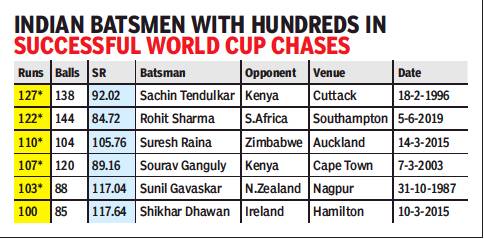
From: Shashank Shekhar, June 7, 2019: The Times of India
' See graphic ‘:
Indian batsmen with hundreds in successful world cup chases, 1996- 2015
Comebacks
1983-2019: the world’s best three
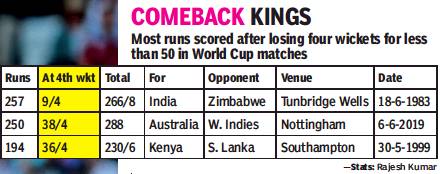
From: Gaurav Gupta, June 7, 2019: The Times of India
See graphic:
Most runs scored after losing four wickets for less than 50 in World Cup matches, 1983-2019
Bowling
The biggest wicket-takers: 1975-2015

From: May 18, 2019: The Times of India
See graphic, ' The biggest wicket-takers in World Cup (cricket), 1975-2015: International and Indian '
Opening matches
1975-2015: India’s record
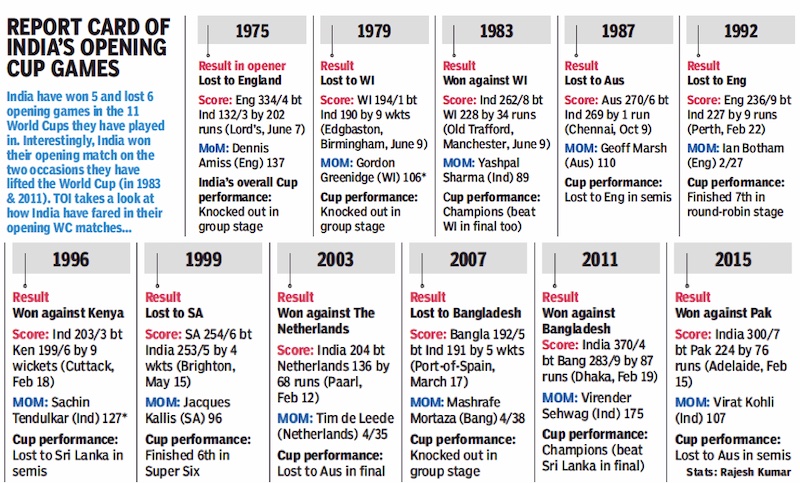
From: June 4, 2019: The Times of India
See graphic, ' India’s record in World Cup opening matches, 1975-2015 '
South Africa vs India
1992-2015: four highlights
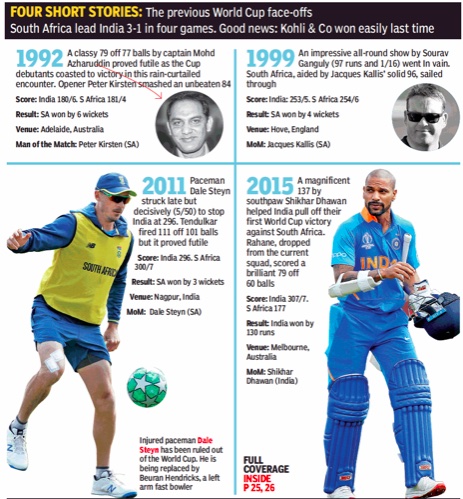
From: June 5, 2019: The Times of India
See graphic:
South Africa vs India at the WC/ 1992-2015: four highlights
New Zealand in the semi-finals
THE GREAT KIWI SEMIFINAL JINX
The Times of India Mar 23 2015
After this article was written, NZ won the semi-finals of the 2015 World Cup, though it lost in the finals.
It's not just South Africa who choke in big matches. New Zealand too have failed to cross the semifinal barrier, losing in all their six previous World Cup attempts. They will hope it's a case of seventh-time lucky on Tuesday. Below is the Black Caps' litany of last-four woes:
1975, THE OVAL
New Zealand 158 (G Howarth 51; B Julien 4-27) lost to the West Indies 159-5 (A Kallicharran 72, G Greenidge 55) by 5 wkts Left-arm paceman Bernard Julien's haul was mainly responsible for New Zealand batting fewer than 53 of their then scheduled 60 overs. A secondwicket stand of 125 between Gordon Greenidge and Alvin Kallicharran then took the West Indies to the brink of victory.
1979, OLD TRAFFORD
New Zealand 212-9 (J Wright 69) lost to England 221-8 (G Gooch 71, M Brearley 53) by 9 runs New Zealand great Richard Hadlee took a miserly one for 32 in 12 overs but fifties from Graham Gooch and England captain Mike Brearley saw the hosts to a decent total. Opener John Wright anchored New Zealand's chase but failed to find support from the other end as NZ lost wickets at regular intervals. 1992, AUCKLAND New Zealand 262-7 (M Crowe 91, K Rutherford 50) lost to Pakistan 264-6 (Inzamam-ul-Haq 60, Javed Miandad 57 no) by 4 wkts New Zealand captain Martin Crowe led from the front and helped New Zealand set Pakistan a stiff chase. Pakistan were 140 for four after 35 overs, needing 123 from the last 15. Inzamam-ul-Haq announced himself to the world with a brilliant innings of 60.
1999, OLD TRAFFORD
New Zealand 241-7 lost to Pakistan 242-1 (Saeed Anwar 113 no, Wajahatullah Wasti 84) by 9 wkts New Zealand managed what seemed a decent total, but were undone by a superb opening partnership of 194 between openers Saeed Anwar and Wajahatullah Wasti. The match ended in chaos when Roger Twose abandoned an attempt to catch Anwar as spectators charged on to the field, with the remaining two runs awarded later by the umpires.
2007, KINGSTON
New Zealand 208 (M Muralitharan 4-31) lost to Sri Lanka 289-5 (M Jayawardene 115 no, U Tharanga 73) by 81 runs S ri Lanka piled up an imposing total. In reply, New Zealand struggled with the bat, with offspin great Muttiah Muralitharan taking four wickets.
2011, RPS COLOMBO
New Zealand 217 (S Styris 57) lost to Sri Lanka 220-5 (T Dilshan 73, K Sangakkara 54) by 5 wkts New Zealand struggled for runs, with Scott Styris playing largely a lone hand. Fine fifties from Dilshan and Sangakkara meant that they inflicted another defeat upon NZ. AFP
PART B: STATISTICS
Captains
Winning streaks, 1975-2015
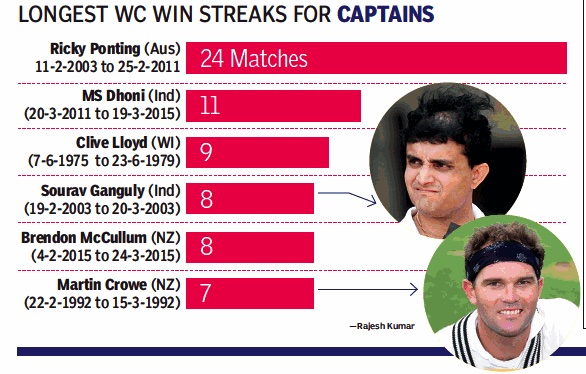
From: May 19, 2019: The Times of India
See graphic:
See graphic, ' The longest Winning streaks for Captains (International and Indian) in World Cup (cricket), 1975-2015 '
Records, statistics
Wickets taken by …
…wrist-spinners, 1999-2019 (part)
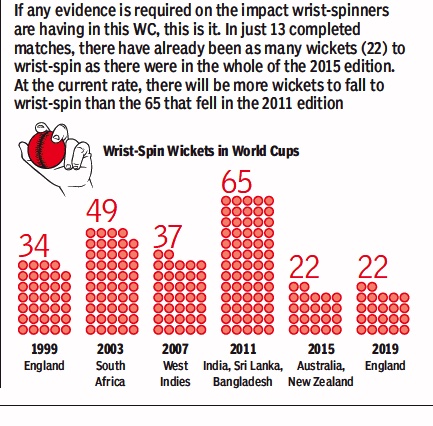
From: June 13, 2019: The Times of India
See graphic, ' Wickets taken by wrist-spinners in the WC, 1999-2019 (till June 11) '
See also
World Cup (cricket): history <>World Cup (cricket): 1975 <>World Cup (cricket): 1979 <>World Cup (cricket): 1983 <>World Cup (cricket): 1987 <>World Cup (cricket): 1992 <>World Cup (cricket): 1996 <>World Cup (cricket): 1999 <>World Cup (cricket): 2003 <>World Cup (cricket): 2007 <>World Cup (cricket): 2011 <>World Cup (cricket): 2015